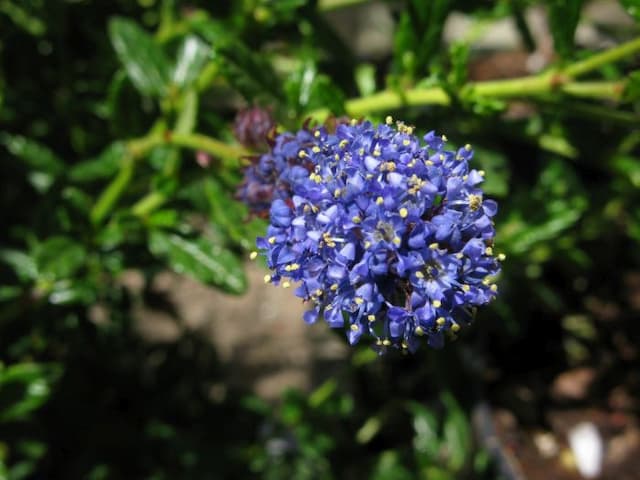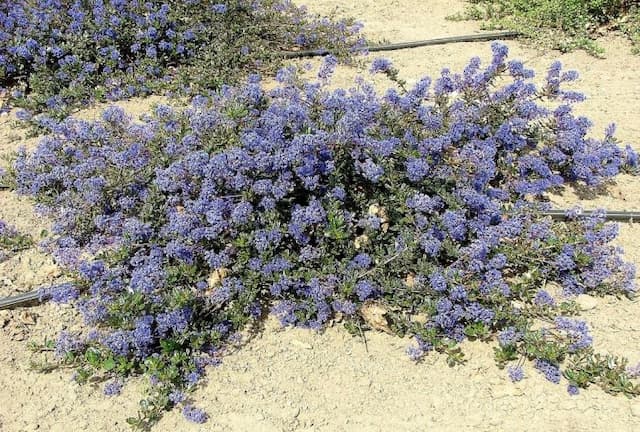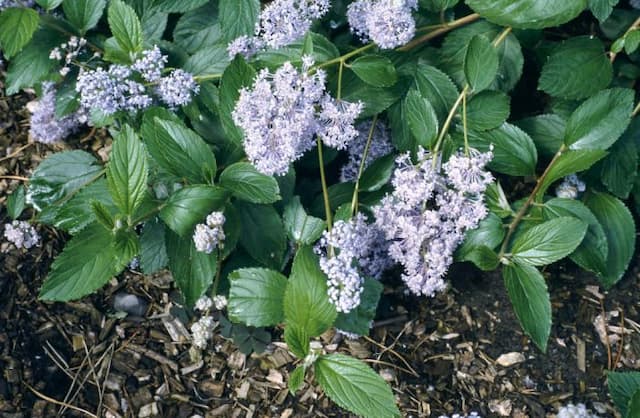Santa Barbara Ceanothus Ceanothus impressus

ABOUT
The plant commonly known as the Santa Barbara ceanothus boasts an eye-catching display. It is adorned with small, rounded leaves that have a glossy green upper surface and a paler, almost whitish underside. Each leaf appears slightly crinkled, with the edges rolling under, giving them a distinctive, almost sculpted look. In bloom, this plant is truly a spectacle, covered in clusters of tiny, intensely blue flowers. These blossoms are compacted into rounded or slightly elongated clusters that stand out against the foliage. The color of the flowers can range from a deep, purplish-blue to a lighter sky blue, making it a vibrant addition to any setting. The Santa Barbara ceanothus also has a rigid, bushy form, with branches growing densely packed together. Its stems can be reddish when young but mature to a grayish hue, adding further contrast to its bright green leaves and stunning blue flowers. This contrast between the stems, leaves, and blooms creates a striking visual impact, especially when the plant is seen covered in a profusion of blue during its blooming period.
About this plant
 Names
NamesFamily
Rhamnaceae
Synonyms
Santa Barbara Ceanothus, Impressus Blue Blossom
Common names
Ceanothus impressus var. nipomensis, Ceanothus papillosus var. roweanus
 Toxicity
ToxicityTo humans
Santa Barbara Ceanothus or Ceanothus impressus is not widely known to be toxic to humans. However, as with many plants, it may cause gastrointestinal discomfort if ingested in large quantities. Most literature does not report it as a plant with significant toxic properties or describe specific symptoms of poisoning for humans. Therefore, there are generally no widespread concerns regarding its toxicity for people, but it is still advisable not to eat any part of this plant.
To pets
Santa Barbara Ceanothus, specifically Ceanothus impressus, does not have a reputation for being highly toxic to pets, such as dogs and cats. There is limited information on its effects if ingested by household pets, but it is generally not listed among the commonly recognized poisonous plants in regards to pets. Nonetheless, to be cautious, it is recommended that pets are not allowed to ingest parts of this plant to prevent any potential gastrointestinal upset or other unforeseen reactions.
 Characteristics
CharacteristicsLife cycle
Perennials
Foliage type
Evergreen
Color of leaves
Green
Flower color
Blue
Height
6 feet [1.8 meters]
Spread
6 feet [1.8 meters]
Plant type
Shrub
Hardiness zones
8
Native area
California
Benefits
 General Benefits
General Benefits- Attracts Pollinators: Ceanothus impressus, commonly known as Santa Barbara Ceanothus, is highly attractive to bees, butterflies, and other pollinating insects, which is vital for the ecosystem.
- Drought Tolerance: Santa Barbara Ceanothus is well adapted to dry conditions, making it suitable for xeriscaping and low-water gardens.
- Erosion Control: The extensive root system of this plant helps to stabilize soil on slopes and hillsides, preventing erosion.
- Easy Maintenance: Santa Barbara Ceanothus is known for being low maintenance, requiring little pruning or supplemental watering once established.
- Landscape Aesthetics: With deep blue flowers and glossy green leaves, it adds aesthetic value to gardens and landscapes.
- Habitat Support: Serves as habitat and provides food for various wildlife species, including beneficial insects and birds.
- Fast Growth: Santa Barbara Ceanothus tends to grow quickly, providing cover and landscape impact relatively soon after planting.
- Evergreen: As an evergreen shrub, it maintains its foliage year-round, offering consistent visual interest.
 Medical Properties
Medical PropertiesThis plant is not used for medical purposes.
 Air-purifying Qualities
Air-purifying QualitiesThis plant is not specifically known for air purifying qualities.
 Other Uses
Other Uses- Dye Production: The flowers of the Santa Barbara ceanothus can be used to produce a natural green dye for textiles.
- Low-Irrigation Gardening: This plant is suitable for xeriscaping or drought-resistant landscapes, helping conserve water.
- Erosion Control: Santa Barbara ceanothus's extensive root system can help stabilize slopes and prevent soil erosion.
- Hedge Planting: Dense growth habit allows it to be used as an informal hedge or privacy screen in gardens.
- Wildlife Habitat: A valuable plant for wildlife, providing food and shelter for birds, bees, and butterflies.
- Bonsai Creation: It can be trained as a bonsai, offering an appealing aesthetic for plant enthusiasts.
- Perfumery: The flowers could potentially be used to extract essential oils for perfumes with a unique scent profile.
- Landscape Restoration: Can be used in native plant restoration projects to re-establish indigenous flora.
- Artistic Inspiration: The striking blue flowers and dark green leaves can inspire botanical art and illustrations.
- Educational Resource: Ideal for use in educational settings to demonstrate the importance of native plants in ecosystem health.
Interesting Facts
 Feng Shui
Feng ShuiThe Santa Barbara Ceanothus is not used in Feng Shui practice.
 Zodiac Sign Compitability
Zodiac Sign CompitabilityThe Santa Barbara Ceanothus is not used in astrology practice.
 Plant Symbolism
Plant Symbolism- Patriotism: Ceanothus impressus, commonly known as Santa Barbara Ceonothus, features vibrant blue flowers that can represent loyalty and faithfulness, similar to the blue found in the American flag.
- Endurance: This plant is known for its hardiness and ability to survive in tough conditions, symbolizing the human spirit's capacity to endure challenges.
- Wild Beauty: The Santa Barbara Ceanothus, with its natural and untamed appearance, often symbolizes wild beauty and a free spirit.
 Water
WaterSanta Barbara ceanothus prefers dry conditions once established and should be watered sparingly. In the growing season, a deep watering every two to four weeks is adequate. Ensure water penetrates 8 to 10 inches below the soil surface to reach the root zone. During the dormant season, reduce watering to once a month if there is no rainfall. Each watering session might require about 1 to 2 gallons depending on soil drainage and temperature.
 Light
LightSanta Barbara ceanothus thrives best in full sun conditions. It should be placed in a spot where it can receive at least six hours of direct sunlight daily. Filtered light or partial shade is acceptable, particularly in extremely hot climates, but the plant's flowering may not be as abundant.
 Temperature
TemperatureSanta Barbara ceanothus is hardy and can withstand a wide range of temperatures, generally preferring conditions between 25°F and 85°F. It can survive minimum temperatures down to about 10°F, but frost can be damaging. The ideal growing temperatures are between 60°F and 75°F to promote healthy growth.
 Pruning
PruningPruning Santa Barbara ceanothus is essential to maintain its shape and promote air circulation. Prune after the flowering season ends, typically in late spring or early summer, to remove dead flowers and shape the bush. Avoid heavy pruning; instead, selectively thin out crowded branches. Pruning can be done annually, but some gardeners prefer to prune every other year to allow for natural growth.
 Cleaning
CleaningNot needed
 Soil
SoilSanta Barbara Ceanothus prefers well-draining soil with low to average fertility and a pH range of slightly acidic to slightly alkaline (6.0 to 8.0). A soil mix consisting of equal parts sand, loamy garden soil, and peat or compost will provide the drainage and aeration Ceanothus impressus requires.
 Repotting
RepottingSanta Barbara Ceanothus does not require frequent repotting and often thrives when left undisturbed. Repotting every 2 to 3 years, or when the plant has outgrown its current container, is sufficient to maintain its health and vigor.
 Humidity & Misting
Humidity & MistingSanta Barbara Ceanothus is tolerant of a wide range of humidity levels and typically adapts well to the average humidity found in its native or similar Mediterranean climates. Therefore, specific humidity adjustments are generally not necessary for this plant.
 Suitable locations
Suitable locationsIndoor
Place near a sunny window in well-draining soil.
Outdoor
Full sun, well-draining soil, mitigate harsh winds.
Hardiness zone
8-10 USDA
 Life cycle
Life cycleThe Ceanothus impressus, commonly known as Santa Barbara ceanothus, begins its life cycle as a seed, which germinates typically after fire or soil disturbance breaks seed dormancy. Upon germination, the seedling establishes a root system and sprouts a rosette of leaves, initiating the vegetative phase where the plant invests in growth and development. As the Santa Barbara ceanothus matures, it enters the reproductive stage, characterized by the prolific blooming of small blue or purple flowers, usually from late winter to early spring, attracting pollinators and proceeding with sexual reproduction. Following pollination, the flowers develop into fruit capsules, which upon maturity, release seeds completing the generative phase. These seeds may lie dormant in the soil for many years, awaiting the right conditions (often fire), to start a new generation. In favorable conditions, Santa Barbara ceanothus can live for approximately 10-25 years, during which it may repeatedly bloom and set seed, thus continuing its life cycle.
 Propogation
PropogationPropogation time
Spring to Summer
For the California lilac (Ceanothus impressus), the most popular method of propagation is through semi-hardwood cuttings. The best time to take these cuttings is during late summer, after the new growth has begun to mature and harden slightly. To propagate, take cuttings from this year's growth, making sure each piece is about 4 to 6 inches (10 to 15 centimeters) long and contains several leaf nodes. Strip off the lower leaves and dip the cut end in rooting hormone to encourage root growth. Plant the cuttings in a well-draining soil mix, ensuring that at least two nodes are buried where roots and new shoots can develop. Keep the soil moist and the cuttings in a warm environment with indirect light until they have rooted, which typically takes a few weeks. Once rooted, the new Ceanothus plants can be gradually hardened off before transplanting outside.









